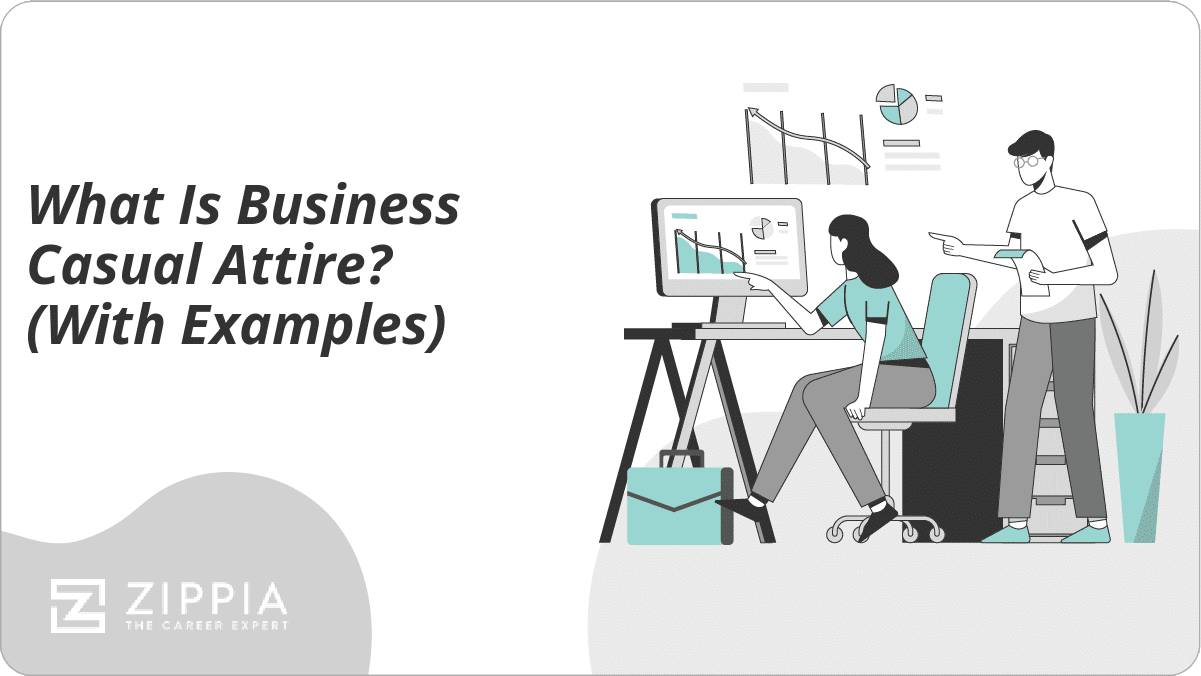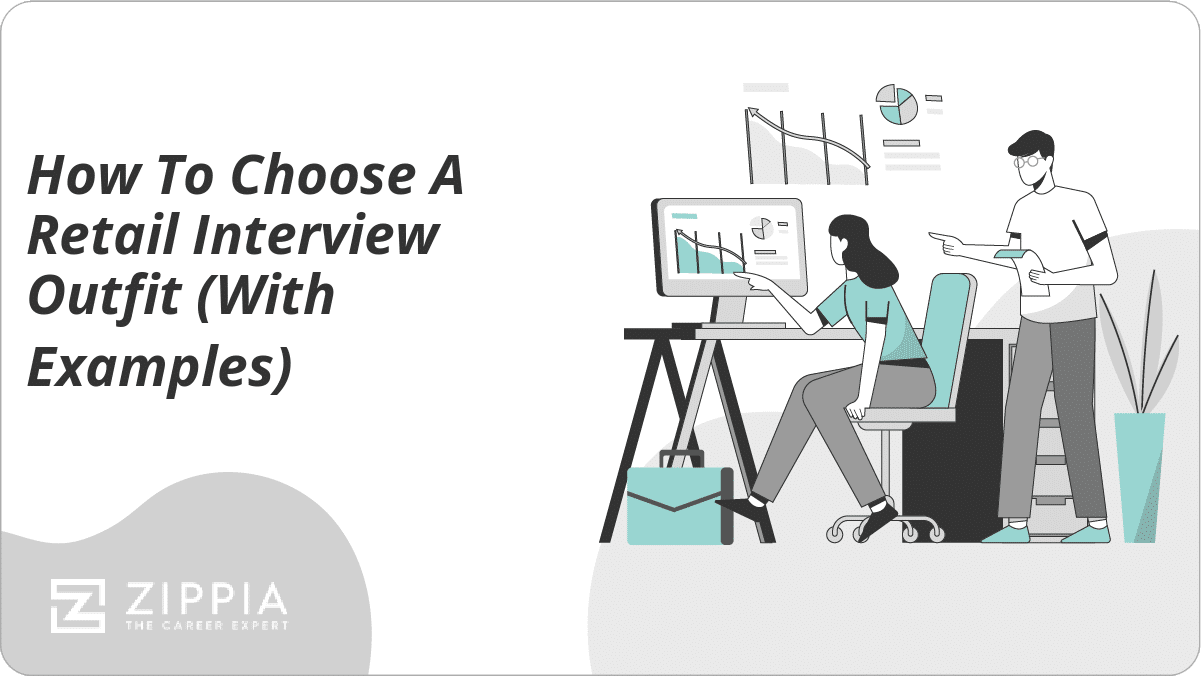- Interview Attire Styles
- Interview Attire For Women
- Interview Attire For Men
- Attire For Specific Locations
- Interview Attire Tips
Find a Job You Really Want In
If you just landed a job that has a dress code of business professional but have no idea what it means, don’t worry.
We’ll cover everything you need to know about business professional, business casual, and other work-wear terms.
Key Takeaways:
-
Business professional means it is more serious and formal than business casual.
-
It’s important to follow the dress code etiquette and remember that sometimes formal isn’t always better.
-
Following the dress code and dressing like those around you will make you fit in better and instantly look like you belong.

What Does Business Professional Attire Mean?
Since you were told that you need to dress this way, let’s look at it first. Business professional definitely implies it’s more “serious” than business-casual; it’s right in the name after all.
-
A business professional atmosphere can mean business suits, both for men and women. There isn’t a lot of leeway when it comes to men’s clothes beyond that, maybe a blazer and dress pants instead of a suit. Maybe it’s ties optional but that’s about it.
-
For women, the boundaries are more flexible. A suit always goes over nicely, but you too can get away with a blazer or leaving the jacket at home altogether. A well-tailored dress can have a very professional finish. You can even pair a modest skirt or trousers with a blouse and come up with a business professional outfit.
The key is to keep it very conservative, wear subtle prints, if any, and lean toward dark colors or neutral hues.
-
Unfortunately, for the fashion maven, business professional rarely means trendy. If you love cutting-edge clothing and making a statement with what you wear, this style of dress is probably not going to be your favorite.
Business Professional Clothing With Examples
-
Business professional clothing for men:
-
Wear a suit in a dark color that’s neutral
-
Ties should be simple
-
Button-down dress shirts in white, cream, or light pastels
-
No white socks
-
Dress shoes; an oxford or a loafer
-
Brown suits go with brown shoes. Black suits go with black shoes. Grey suits usually go with black shoes. Dark/Olive green suits and navy suits usually go with brown shoes.
-
If your clothing is starting to look worn, outdated, or isn’t fitting well – then it’s time for something new
-
Conservative is the name of the game for you
-
-
A charcoal grey suit, black dress socks, black dress shoes, a light blue button-down oxford-style shirt, a royal blue tie that has a modest print.
-
A dark brown suit, brown dress socks, brown oxford shoes, a white dress shirt, a silk tie with a subtle floral print.
-
Men’s ties — tie fashion in recent years is typically a bit too bold for business professional but it fits right in with business casual. For a more professional look, opt for small prints. Floral prints have made it into the business world quite successfully, so that and paisleys are usually safe.
-
Business professional clothing for women:
-
A business suit with pants or a skirt is a good idea
-
Have a few button-down oxford-style blouses to mix and match with your suit pieces
-
Blouses that aren’t too low cut or billowy often work well
-
Dresses should come to the knee or lower
-
Select dresses that are so professional, you wouldn’t wear them anywhere else but the office (or maybe a funeral)
-
Most business professional offices require hose, nylons, tights or something along those lines – no bare legs
-
Closed toed shoes and a modest heel is expected
-
Too much jewelry or jewelry that’s very large and distracting is frowned upon
-
Conservative clothing should be your goal
-
-
A solid black dress with a modest neckline and a hemline at the knees, black Mary Jane shoes, nude nylons, a simple strand of pearls and earrings to match. You can add a fashion scarf for a little color and personality.
-
Navy pantsuit with a light pink blouse, paired with navy flats. Accessorize with simple hoop earrings.
-
Shoes are really important – we understand. Unfortunately, not all workplaces do. The key is really to keep your work shoes comfortable and conservative and your play shoes fun. This is a good compromise.
Dress Code Is Etiquette
Remember that dressing to impress someone isn’t just a good idea, it’s part of business etiquette. It’s just as important as offering a good handshake or greeting, being an active listener, and showing respect. In fact, most business etiquette revolves around respect.
Once you’ve selected an outfit that’s in keeping with the office dress code, you’re going to feel so much more confident when you walk in the door. When you feel like you fit in and look appropriate, it can be a big boost to your confidence. It can even help you nail an interview or rock your first day at work.
Mistakes to Avoid When It Comes to Dressing Business Professional
There are so many mistakes you can make. From little ones like forgetting to zip up your pants (always do a fly check before heading into the office) to big ones like wearing a t-shirt with a rude slogan because you want to show off your personality.
If you’re going to a job or interview and the dress code is business professional, avoid the following:
-
Ill-fitting clothing
-
Clothing that is too revealing
-
Stained clothes
-
Wearing white socks
-
Wrinkled clothing
-
Clothing that doesn’t smell fresh
-
Wearing too many accessories
-
Beat up old shoes
-
Bold or busy clothing
-
Deciding to skip the dress code and show your personality
The clothing mistakes above are geared to anyone who is working in a business professional office or interviewing for a job. If you’re interviewing, then dressing a notch (or two) above what will be expected of you on a daily basis is a good idea. It shows respect for the interviewer and the job. It also says that you’re very serious about this position.
Dressing appropriately also signals to the people around you that you’re one of them. You instantly look like you belong, so they’ll accept that you do. It can also help everyone move past appearance and focus on the job at hand. Now that’s a win/win for everyone.
Tips for Dressing Business Professional
We’ve covered the basics, but if you really want to nail your business professional look, consider these additional tips:
-
Follow the leader. If you’re new to an office environment, figuring out what business professional really means might take some time.
While you might err on the side of over-dressing for your first week, keep an eye on how your coworkers and supervisor(s) dress. Seeing what a dress code looks like in reality can be invaluable for informing your wardrobe decisions.
-
Research the company before a job interview. Big companies usually have active social media pages and high-quality websites. Even smaller companies often have pictures of their staff somewhere online.
Start with the company’s “About Us” page and go from there. Having some insight on what business professional means to the specific company will make planning your interview attire much easier.
-
Find a tailor. Business professional clothing isn’t cheap, so you don’t want to be getting a whole new work wardrobe every year. But sizes and fits change over time, which can make your old clothes ill-fitting and worse-looking.
To save yourself money overall and keep your hard-earned wardrobe looking fresh, find a tailor you like and make a trip whenever the occasion arises.
-
Focus on quality, not quantity. Again, business professional clothing tends to be pricey — at least, the high-quality stuff does. We recommend having a smaller wardrobe comprised of nicer clothes rather than a wide variety of cheap ones. In the long run, it’s just as expensive to have to replace poor quality clothing regularly than to just get nice stuff that can stand the test of time.
-
Be hygienic. Business professional attire isn’t just about how you look — it’s about how you smell as well. Don’t be the person who wears way too much perfume or cologne. Or, even worse, the person who clearly hasn’t bathed in a while.
Additionally, make sure that your hair is tidy and your nails are clean and well-manicured — people notice these things.
-
Plan ahead. Dressing like a C-level executive isn’t easy. It can be downright stressful if you’re new to the dress code. Do yourself a favor and plan your outfits in advance. That way, you won’t have to stress about it in the morning, right before going to work. Plus, with a plan, you can make sure that you’re varying your clothing choices regularly enough.
-
Following washing instructions. In order to keep your fancy business professional clothes looking good, make sure to follow the washing directions listed on the label. If something says dry clean only, throwing it in the washer/dryer could be a disaster.
Business Professional Attire FAQ
-
What Does Business Casual Attire Mean?
If you work in an office that claims to be business casual all the time, then you might never need a suit, but you’ll still be wearing dress clothes.
These offices tend to be a little more relaxed in their dress codes. You’ll see a bit more personality and individual style, some bright colors, and even bold prints. More dress pants and dresses than suits and sportscoats. But you’re probably not going to see jeans – that’s just too casual.
So how about the office that typically dresses down, one where wearing jeans is expected -– except for business casual days. This does happen in some jobs. Let’s say you work in a print shop and you wear jeans and any top you want on a regular basis. But one day a month you host your clients for an open house. This day you’ll need to wear business casual.
Luckily for you, that definition tends to be even more relaxed than the others. A nice pair of clean and not ripped jeans might do. A pair of khakis would probably be even better. And a great polo top or even a button-down shirt pairs well with either pants option. You can even wear a sweater and fit right in.
-
What Does Casual Wear Mean for Business?
If you work in a business that says their dress code is casual, that could mean a couple of things.
If it’s an office, you’re probably still expected to wear khakis or dress pants, but your top could be a polo or a simple sweater. You might be able to get away with clean and neat-looking jeans, but don’t assume. It’s always best to dress a little nicer and then check out your co-workers to see what they wear.
If you work in a shop, on a factory floor, or somewhere that doesn’t entertain customers or clients, casual could be more relaxed. In this environment, t-shirts and jeans might be the standard style.
-
What Does Business Formal Clothing Mean?
Business formal is traditionally a step more conservative and dressier than business professional.This can also be referred to as boardroom attire. It’s the highest level of professional dress and quite often is used to impress or show respect to clients when in meetings.
For men, it absolutely means a suit with a tie. You might even want to include a vest to round out that three-piece suit look. Neutral colors and the more somber dark tones tend to go well.
For women, a suit is still preferred, but you can wear your suit with pants or a skirt. Plan to wear nylons or tights if you choose a skirt suit. Dark colors are, again, a better choice, and a very subtle matching shoe is preferred. A blouse or shirt in a light color is usually best and it needs to be tucked in.
Choose your accessories carefully, so they’re not too noticeable or distracting.
-
Why Does It Matter What You Wear to a Job Interview or to Work?
Dressing appropriately for a job interview or the job itself is really important. This is your chance to make that first impression and show them how well you fit with the company culture. You put a lot of work into getting the interview or the job and you don’t want to ruin it by not caring about your appearance.
Sure, we can argue back and forth about your appearance not having anything to do with how you do the job. That may be true, but the effort you take to look nice speaks volumes. That’s what employers are going to notice. That and how well you can gauge what’s appropriate in their work environment.
- Interview Attire Styles
- Interview Attire For Women
- Interview Attire For Men
- Attire For Specific Locations
- Interview Attire Tips





